|
. In this day
and age, most people have little contact with glass beyond the utilitarian;
glass is used for windows, containers and vessels, while plastic is slowly
replacing glass even for these mundane functions. Meanwhile, aside from the
rare “art” glass vase, paperweight or museum piece, even our most
decorative glassworks are uninspiring and mass-produced. In light of this,
people might feel no need to rush to a new exhibit at The Metropolitan Museum
of Art which focuses entirely on glass objects from the Islamic world. In
that, however, they would be remiss; for Glass of the Sultans is one of those
rare exhibits which not only presents unique and beautiful objects, but does
so in a well-organized, and informative manner that promises to enlighten
and impress even the most jaded museumgoer.
Glass of the Sultans is the first museum survey of rare Islamic glass, and
contains nearly 160 objects (on loan from 20 institutions) from various regions
in the Islamic world, including Egypt, Syria, Syro-Palestine, Iran, Iraq,
and Central Asia, dating fr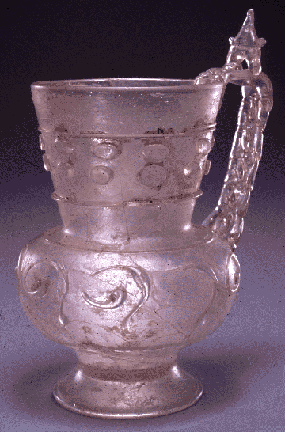 om the 7th to 14th Century, as well as later works
from Persia, India, and Europe in the Islamic style. The range of material
is thus wide-including a vast array of shapes, styles and colors--unexpectedly
so for those of us uninitiated to the variety of techniques in glassmaking.
Wisely, the curators have chosen to arrange the works primarily by these
techniques rather than by region or chronology, with several sections devoted
to specific themes such as Islamic glass found in archaeological sites, and
European works imitating or inspired by Islamic glass. With equal acumen,
the objects are widely-spaced, and displayed in well-lit cases on lustrous
fabrics of neutral colors, thereby encouraging the refraction and play of
light which is necessary to catch the true beauty of any glasswork. om the 7th to 14th Century, as well as later works
from Persia, India, and Europe in the Islamic style. The range of material
is thus wide-including a vast array of shapes, styles and colors--unexpectedly
so for those of us uninitiated to the variety of techniques in glassmaking.
Wisely, the curators have chosen to arrange the works primarily by these
techniques rather than by region or chronology, with several sections devoted
to specific themes such as Islamic glass found in archaeological sites, and
European works imitating or inspired by Islamic glass. With equal acumen,
the objects are widely-spaced, and displayed in well-lit cases on lustrous
fabrics of neutral colors, thereby encouraging the refraction and play of
light which is necessary to catch the true beauty of any glasswork.
Fig.1: Ancient glass vase, with raised designs (Glass of the Sultans,
Metropolitan Museum of
Art).
The exhibit opens with a single case introducing the eight major glassmaking
techniques, each with a single example. The most unusual object here is a
bowl probably made in Iran in the 9th-10th century which was given as a gift
from the ruler of the Turkoman Aq-Koyunlu to the Venetian Signoria in 1472,
and later set in a gold and silver mount and placed in the treasury of St.
Mark's Cathedral in Venice. The opaque turquoise blue color of the glass
is rare, and the inscription "Khorasan", a region in Northeast Iran where
turquoise stone is known to originate, may hint at a past attempt at deception.
Also in this introductory area is a display of the tools used to manufacture
glass, including two of the only dip-molds to survive from the medieval Islamic
world. A video is most helpful here in demonstrating some of the basic
glassmaking techniques to those who have never before observed them.
As an archaeologist, I much appreciated a small section focusing on glass
obtained from the scientific excavation of Islamic sites. Unfortunately,
I have observed too often the indifferent recovery of glass shards from eve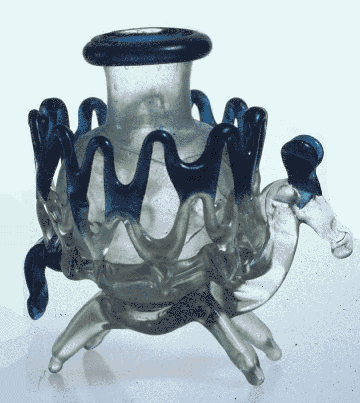 n
much older sites (Roman and Byzantine), so it is comforting to see that
archaeologists in the Near East, especially in Israel, have given this material
so much careful attention. Text in this section outlined some of the problems
related to the study of excavated glass, including the wide distribution
of glassworks as luxury goods in trade, as well as the shipping of discards
to be melted down and reused. This ancient recycling system prohibits researchers
from determining the provenience of an object from its chemical composition
alone, but other studies of chronology and manufacture are furthered by the
study of excavated glass. n
much older sites (Roman and Byzantine), so it is comforting to see that
archaeologists in the Near East, especially in Israel, have given this material
so much careful attention. Text in this section outlined some of the problems
related to the study of excavated glass, including the wide distribution
of glassworks as luxury goods in trade, as well as the shipping of discards
to be melted down and reused. This ancient recycling system prohibits researchers
from determining the provenience of an object from its chemical composition
alone, but other studies of chronology and manufacture are furthered by the
study of excavated glass.
Fig.2: Zoomorphic glass flask from Syria made with openwork technique
(Glass of the Sultans, Metropolitan Museum of Art).
The next section
is devoted to objects made by the most basic technique, glassblowing. While
slower and more labor-intensive glassmaking techniques had been used since
the third millenium BC, it was the invention of glassblowing in the first
century BC in Syro-Palestine that increased the production and availability
of glassware, as well as broadened the range of forms and styles possible.
While pr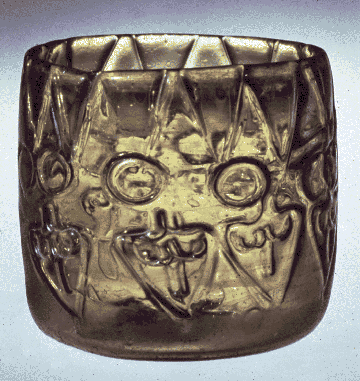 imarily undecorated, the forms of many of the utilitarian objects
shown in this section, such as a delicate Qumqum (sprinkler for perfumed
water) reveal the artfulness and skill of their creators. imarily undecorated, the forms of many of the utilitarian objects
shown in this section, such as a delicate Qumqum (sprinkler for perfumed
water) reveal the artfulness and skill of their creators.
A rapid addition to the basic glassblowing technique was the inflation of
glass into a mold, as adopted first by the Romans in the first century AD
and soon spread into Near Eastern lands. Molds enabled both the basic form
and decoration of an object to be duplicated. Simple patterns such as vertical
ribbing or fluting, chevrons or vegetal designs were common, but so were
more complex designs such as inscriptions wishing the owner well.
Fig.3: Glass cup (9-10th c. AD) with relief patterns made from metal
stamps (Glass of the Sultans, Metropolitan Museum of Art).
Hot-worked glass includes objects manipulated and decorated when the blown
vessel is still hot and malleable. In one subset of this technique, hot trails
of glass are applied to the object as it is rotated, to form various raised
designs (fig. 1; #37). This technique is used to form an openwork glass
“cage” in a group of zoomorphic flasks from Syria (fig. 2; #29.)
In another subset, metal tongs ending in a design were impressed against the
interior of hot vessels to form relief patterns on the outer wall. Thus the
technique was primarily used to form simple patterns on open shapes, such
as on a small 9-10th century cup (fig. 3, #47), but closed shapes were also
formed by joining two separate sections. Three medallions which decorated
windows grills in a 12th-13th century palace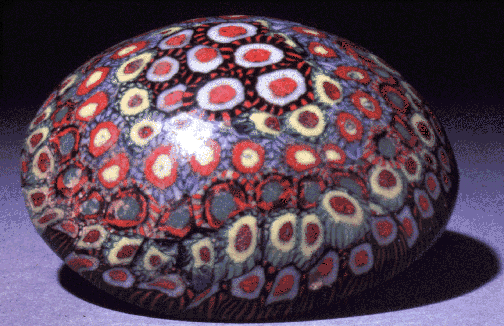 at Old Termez, Uzbekistan also
employ this technique. Another hot-working technique integrated the trails
of glass into the vessel by rotating against a marver, or polished slab.
Such marvered trails are usually white, and often combed to form a meandering
pattern against a darker colored background. at Old Termez, Uzbekistan also
employ this technique. Another hot-working technique integrated the trails
of glass into the vessel by rotating against a marver, or polished slab.
Such marvered trails are usually white, and often combed to form a meandering
pattern against a darker colored background.
Fig.4: Mosaic glass (Glass of the Sultans, Metropolitan Museum
of Art).
Mosaic glass is manufactured from a time-consuming technique in which long
canes of glass, created by gathering glass of different colors around a core,
are then sliced to form individual roundels. These slices are then arranged
around a mold and heated so they fuse together. Often referred to as 'millefiori'
(thousand flowers, in Italian) for the resultant colorful pattern (fig. 4;
#62), mosaic glass was especially po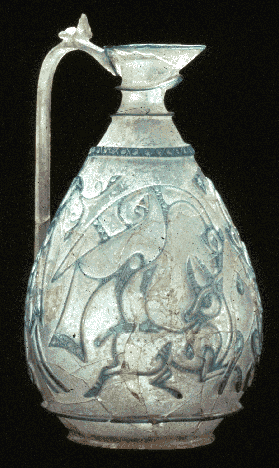 pular in Mesopotamia and Syria during
the 8th and 9th centuries. pular in Mesopotamia and Syria during
the 8th and 9th centuries.
One of the
earliest techniques for working glass was through cutting and engraving.
On display here are several very different groups of objects which use this
basic technique, including those with rather distinctive scratch-engraving,
fine incisions, or honeycomb patterns of facet-cut decorations. The masterful
“Corning Ewer” features “cameo glass” created by encasing
light green glass over colorless glass in a Roman-inspired design of stylized
animals (fig. 5; #90). A rare and challenging technique particularly popular
in Egypt and Syria in the 7th-9th century was stained, or luster-painted,
glass. Using silver or copper-containing pigments glassware was painted and
then fired until the designs were permanently fixed.
Fig.5: The Corning Ewer, showing faceted animal patterns
(Glass of the Sultans,Metropolitan Mus.of Art)
It is with
the opulent and vibrant enamel and gilded glass, however, that we see the
true artistry applied to glassworks in the Islamic world (fig. 6; #129).
Great skill was required to make these pieces, which required applying gold
and/or enamels (powdered opaque glass) to a glass surface using an oil-based
medium and a brush or reed pen, and then firing to a regulated temperature
that would permanently fix the substances-each with its own melting point--to
the vessel. Highly valued, these works were created for the wealthy and for
sultans, but also for any individual who wished to show the glory of Allah.
It is thus not surprising that vivid enameled and gilded glass was often
used for mosque lamps, empha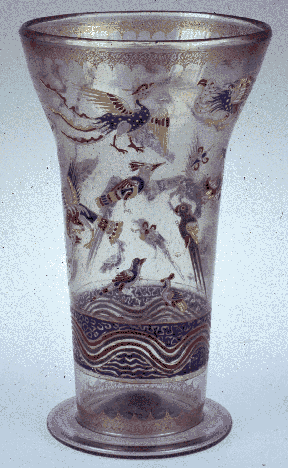 sizing that, as inscribed on one such lamp (cat.
#117), “God is the light of the heavens and earth.” Some of these
lamps are exhibited as they would have appeared to worshippers, hanging from
the ceiling and lit, the better to show the beautiful play of light, color,
and shadow. One unusual lamp (cat. #118) depicts picturesque flowers against
a blue background instead of gold-when lighted we see a garden of paradise.
Similarly, brightly colored birds--identifiable species in fanciful colors--are
portrayed on an unusual beaker-shaped vase from Syria (cat. #128). Perhaps
these are inhabitants of the gardens of Heaven or possibly they refer to
a Sufi parable in which hoopoe, Solomon's sacred bird, leads other birds
on a search for the divine. sizing that, as inscribed on one such lamp (cat.
#117), “God is the light of the heavens and earth.” Some of these
lamps are exhibited as they would have appeared to worshippers, hanging from
the ceiling and lit, the better to show the beautiful play of light, color,
and shadow. One unusual lamp (cat. #118) depicts picturesque flowers against
a blue background instead of gold-when lighted we see a garden of paradise.
Similarly, brightly colored birds--identifiable species in fanciful colors--are
portrayed on an unusual beaker-shaped vase from Syria (cat. #128). Perhaps
these are inhabitants of the gardens of Heaven or possibly they refer to
a Sufi parable in which hoopoe, Solomon's sacred bird, leads other birds
on a search for the divine.
Fig.6: Gilded, enameled glass vase with bird motifs (Glass of the
Sultans, Metropolitan Museum of Art).
Such enameled glass was a specialty of lands controlled by the Ayyubids and
Mamluks (modern Egypt and Syria) during the 13th and 14th centuries, but
by the 15th century fell out of favor there so much that production shifted
to Europe, particularly Venice. The final cases of the exhibit are thus devoted
to glassworks from the “Age of Empires” (16th-early 20th century),
especially fine glass from Mughal
India as well as late imitations of Islamic glass from Europe. Especially
interesting are several 19th century glassmakers who not only copied specific
medieval Islamic works, but were inspired by many different Islamic motifs
and styles to create their own, unique, and elegant works.
.
Reviewed by Michele A. Miller
This article appears on pp. 78-79 in the Museum Reviews section of Vol.3, No.2 of Athena
Review.
.
|
|